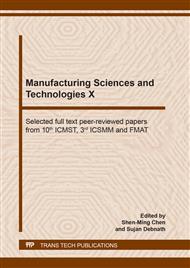p.3
p.8
p.18
p.23
p.28
p.36
p.43
p.49
The Effect of Aging on the Decrease in Tensile Strength of Composites with Palm Oil Kernel Shell Powder
Abstract:
Polymeric composite materials with natural renewable fillers are materials that are environmentally sensitive and can be an important alternative to conventional materials. One of the possibilities of using natural fillers is to use natural secondary sources. This paper describes the use of natural waste produced in the processing of palm oil fruits. The experiment describes a change in tensile strength due to an aging of the epoxy resin-based material and particles prepared from palm fruit (PKS). Specifically, the concentration was 30 wt. % and particle size up to 100 μm, 100-200 μm and 200-300 μm. To simulate the aging of the material, a climatic chamber was used which, at regular intervals for 840 hours, changed the ambient temperature from +70 ° C to-40 ° C and humidity. This process caused a decrease in tensile strength of 18.73 MPa for the unfilled epoxy resin and up to 19.27 MPa for the composite system. Comparison with unfilled resin was used to describe the effect of PKS particles on the aging rate. Interphase interaction was described by electron microscopy.
Info:
Periodical:
Pages:
18-22
Citation:
Online since:
June 2020
Authors:
Price:
Сopyright:
© 2020 Trans Tech Publications Ltd. All Rights Reserved
Share:
Citation:


